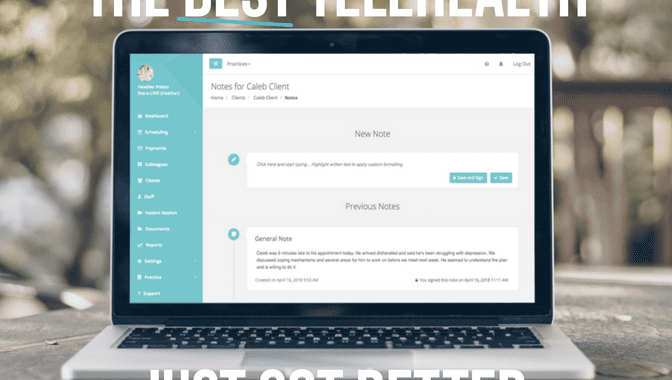Benefits of Telehealth in Rural Areas
Most mental health therapists incorporated telehealth into their practices when the COVID-19 pandemic struck, but telehealth began gaining ground long before that time. For many people in rural areas, telehealth is the only option for receiving mental health services. For this reason, it’s becoming a more common way for therapists to provide quality care to people throughout the country. While there’s a bit of a learning curve for therapists looking to adopt telehealth, the benefits far outweigh the challenges. In this post, we review the benefits of telehealth for rural areas and offer some practical guidance for implementing it in your practice.
4 Benefits of Telehealth for Clients Who Live in Rural Areas
Telehealth has the capability to benefit everyone, especially people in rural areas with limited access to mental health services. Here are four specific benefits of telehealth in rural areas.
A Valuable Tool for Locations that Face an Addiction Epidemic
The opioid addiction epidemic has created a push to both improve and reform addiction treatment. Rural regions of the country are hardest hit by this epidemic, which is especially challenging given the decreased access to mental healthcare providers in rural areas. Through the use of telehealth, people in rural parts of the country have greater opportunity to find a therapist to support them through the recovery process, a key factor in recovery.
The federal government offers grants to support telehealth in rural areas, recognizing that providing improved mental health resources to areas in specific need will aid in fighting the opioid epidemic. More than $72 million in grants are being funded in 2020 to support this important endeavor.
Widens Access for People Who Live Too Far from a Therapist with Availability
According to a study by the U.S. Department of Health and Human Services, there will be a significant shortage of mental and behavioral health providers in the next few years. The country overall is recognizing the importance of mental health treatment, which drives the demand for more therapists. This will impact rural areas even more than urban areas as the relative number of therapists in these areas is lower.
With a telehealth option, a therapist in a nearby urban area or even in another state (with the appropriate license) could treat a person in a rural area with limited access. The technology can help to bridge geographical gaps in coverage where it may be needed the most.
More Convenient for Clients
The ability to offer telemedicine across healthcare, including mental health, has been revolutionary for the industry. People no longer need to make their way to an office, markedly improving accessibility for people in rural areas who may need to drive long distances otherwise. As long as a person can connect to the internet, they have access to treatment.
Making access to telehealth more convenient means an increased likelihood that people will consider getting mental health treatment and that they will stick with it. Therapy is not a “one and done” activity, which you fully understand as a therapist. It takes time to work through issues and see progress. Making sure access is convenient is a great way to get people to reach out for the help they need and to keep them engaged long-term.
Encourages Those Who Fear Stigma to Receive Help in the Privacy of Their Homes
Though mental health treatment has become more socially acceptable, there is still a stigma for some people seeking treatment. Providing a treatment option that people can access in the privacy of their own home will help people feel more comfortable, increasing the likelihood that they will seek treatment and continue with it. Though telehealth doesn’t decrease the social stigma, it does decrease the potential visibility to others, which can help.
Tips for Improving the Telehealth Experience for Clients
Implementing telehealth in your practice will require an adjustment. You’ll have to think through the client experience to consider how you’ll adapt your current processes to this technology. Here are some things to consider as you move forward with telehealth.
- Share what to expect — Let your client know what their telehealth session will be like, including the platform you will use, how to connect to it, and if they need to download anything to prepare. Share contingency plans for if you get disconnected for any reason — you want your client to feel supported at all times.
- Ensure privacy — Choose a space for your telehealth sessions that’s free of distractions and private. You want to be sure no one can hear your conversation and that no one will interrupt it. (If working from home with family members, hanging a sign on the door is a good option!)
- Prevent noise from distracting clients — In addition to providing a private space for the session, you also should make sure there are no noises that could be distracting. This includes the doorbell (again, a sign comes in handy), music, television, phone, and anything else that could be distracting for you or your client.
- Maintain natural eye contact — An online session is meant to feel like an in-person session, so maintaining eye contact is just as important in telehealth. Be careful with how much time you spend looking away from the screen so your client knows they have your full attention. Tell them that you’ll be looking away periodically to take notes when necessary — unlike in an in-person session, your client doesn’t have the benefit of seeing your actions. Consider your setup as well to make sure the camera placement supports maintaining eye contact comfortably throughout the session.
- Provide a stable internet connection — Having reliable high-speed internet is a must for a telehealth session. Test out your connection beforehand. Although WIFI is compatible with many telehealth platforms, a wired connection is typically more stable.
Telehealth is a powerful tool that brings much-needed mental health services to those in rural areas who often have acute needs. While telehealth is an adjustment for both the therapist and the client, when it’s done well, it can have a tremendous positive impact with lasting effects.
See how Thera-LINK, a HIPAA-compliant telehealth platform, can help you connect effectively with your clients.







